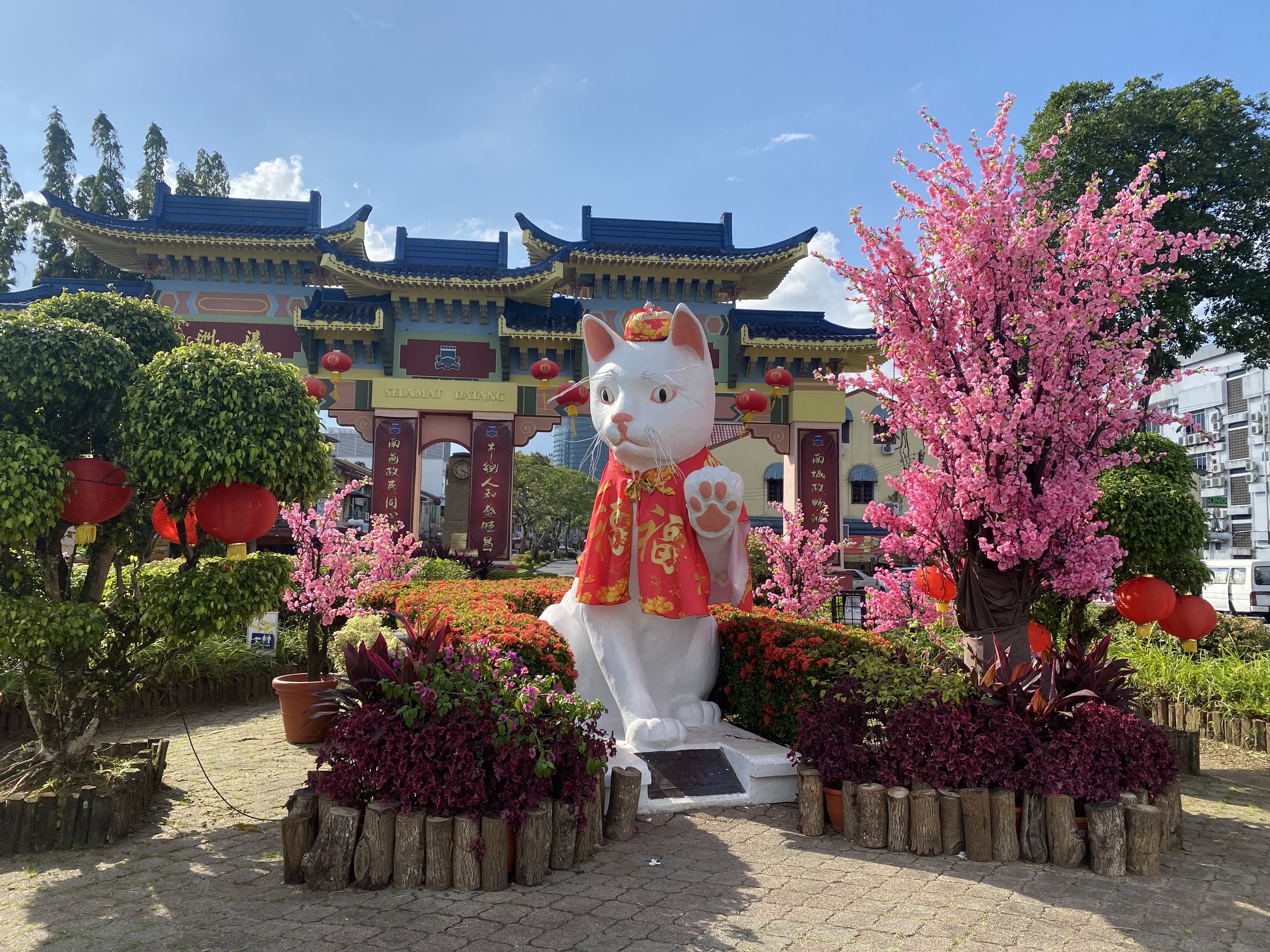Eight things you need to know about Sarawak, Malaysia
Sarawak, the Land of the Hornbills and home to pristine rainforests, magnificent hornbills, and the UNESCO Creative City of Gastronomy– Kuching, has so much more to offer than what meets your eyes.
A unique plethora of culture, adventure, nature, food, and festivals, Sarawak is the place where the journey of endless exploration starts
We are inviting you to join us at PATA Destination Experience Forum & Mart 2023 for an in-depth exploration of this sustainable destination, so we are cramming you these eight facts you must know about Sarawak!
1. Kuching, the capital of Sarawak, is also known as “Cat City”.
The White Cat Statue in Kuching
There are a few widely accepted stories about where this name came from. The most popular version is that when British explorers first arrived in the 19th century, his guide thought he was pointing to a cat instead of the town, thus mistakenly replying 'kucing', Malay for cat. Two other claims are 1) the city was named after a tree that once grew throughout the area bearing a fruit named Mata Kuching, and 2) James Brooke, referred to the town as ‘Kuching’ in 1839, which might suggest the old word ‘Cochin’ or port as in India or Indo-China.
Whatever the story may be, eventually the city of Kuching settled on the moniker of Cat City, because who doesn’t like cats? Today when you visit the city, it is hard for you to miss the cue as cat statues and paintings can be seen everywhere.
Fun fact: The iconic White Cat is dressed up for different festivities throughout the year by the Kuching South Municipal Council.
2. Sarawak is the largest region in Malaysia.
Sarawak and Peninsula Malaysia in comparison
Sarawak is approximately 90% the size of the whole of Peninsula Malaysia in terms of total land area, making it the biggest region in Malaysia.
Sarawak has 67 national parks, 23 which are open to the public. These include:
Mulu National Park
Unesco World Heritage Site Gunong Mulu National Park
Well known today for its rich biodiversity and karst features like its caves and underground rivers, it boasts remarkable 50-meter tall, razorsharp limestone Pinnacles on the northern end of Gunung Api and the biggest underground cave chamber in the world - the Sarawak Chamber - which can fit 40 Boeing 757 aircrafts!
Niah National Park, Borneo’s ‘Cradle of Life’
Niah Caves system boasts one of the largest limestone caves in the world which includes paleolithic and neolithic burial sites, ancient cave paintings and the majestic Great Cave, an important prehistorical site where new discoveries in 2017 suggest that human pre-history has been established to have existed here about 65,000 years ago.
3. Kuching became the first Malaysian city to earn recognition as a UCCN City of Gastronomy!
Sarawak’s diversity in ethnicities and cultures has created a wealth of authentic dishes and food that remain staples of their indigenous households, passed down through generations, making Sarawak not only a destination rich in nature and culture, but also a place to enjoy and relish its variety of local foods.
Among Sarawak’s must try dishes are:
Sarawak Laksa (praised as the ‘Breakfast of the Gods’ by the late Anthony Bourdain)
Sarawak kolo mee (A flavourful springy dry noodle dish)
Ayam Pansuh (Chicken ‘pressure-cooked’ in bamboo)
Gula Apong Ice Cream (a sumptuous ice cream made of nipa palm sugar which also happens to be one of Korean celebrity Yoo Seung Ho’s favourite desserts in Kuching)
Kek Lapis Sarawak (Sarawak layered cake, which was a special signature challenge featured on the Great British Bake off)
Sarawak Laksa
Kek Lapis Sarawak
4. Sarawak only became a part of Malaysia in 1963.
Sarawak has, in fact, been a part of Brunei for the longest time from the 15th century to 1841. After Brunei, the Brooke dynasty administered Sarawak for a century until in 1941 when Japan occupied the island during WWII. Between 1945-1963, Sarawak, together with Sabah, became Crown Colonies under the British Empire. was a part of the British colonial. This year, Sarawak celebrates the 60th anniversary of the formation of the Federation of Malaysia in 1963 with the rest of the country.
5. Sarawak is also known as “Land of the Hornbills” because the Rhinoceros hornbill is Sarawak’s state emblem.
Despite having the famous “Cat City” and being a major sanctuary for the Orangutans, the Hornbill is the actual spirit animal of the state, literally! Thus the name “Land of the Hornbill”. It is the Dayak’s belief that Rhinoceros Hornbills represent the spirit of God; seeing one fly across the house brings good luck to the community.
Sarawak boasts 8 out of all 54 species of the hornbills. If you wish to see this majestic creature yourself, head to Kubah National Park approximately 23 kilometres (15 miles) west of the state capital Kuching.
And you should definitely not miss the signature Bornean orangutans as well! There are two spots to visit these red-haired friend: Semenggoh Wildlife Centre just 20 KM away from Kuching and Batang Ai National Park where you can see orangutans in the wild.
Rhinoceros Hornbill
Borneo Orangutan
6. 60% of Sarawak’s energy is reusable.
Having all these valuable resources makes conservation and responsible development even more critical for Sarawak. From 2010 to 2020, Sarawak was able to decarbonise its power system by more than 70%, and its clean hydrogen production capacity has more than doubled since January 2021.
7. Sarawak’s tourism is all about being responsible.
Having said that, it is for sure that Sarawak’s tourism is all about being responsible. The destination has been devoting huge efforts to promoting responsible tourism that steers its community towards SDG 4 (Quality Education), SDG 12 (Responsible Consumption and Production), and SDG 17 (Partnerships for the Goals).
Toward visitors, they are actively encouraging eco-friendly tourism products like nature-based activities, community-based tourism, as well as homestays, responsible food-consumption, local handicrafts and arts.
For their supplies, Sarawak Tourism Board provides training on waste management, reducing plastic & carbon footprints, and taking proactive measures to reduce impacts of their major festivals. You will be able to learn more in-depth and first hand insights of how Sarawak is putting sustainability into action at PATA Destination Experience Mart & Forum.
8. The best season to visit is April – September.
The best season to visit Sarawak is April to September for two reasons: 1) It is the period of time when there is the least rainfall, and 2) one of the most happening music festivals featuring world music happens around this time!
The Rainforest World Music Festival is typically held in June in Kuching with daytime music workshops, cultural displays, craft displays, food stalls, and main-stage evening concerts by worldwide indigenous music performers. PDFM this year coincides with this well-received festival which runs from June 23- 25, so we are inviting all our event delegates to join us at this music event with a complimentary ticket to the opening evening stage!
A land of cultural and music festivals, other events that you can look forward to are the Borneo Cultural Festival (Jul 14-23), Asean International Film Festival & Awards (AIFFA) (Aug 3-5), the Sarawak Harvest & Folklore Festival (Jul 7- Sep 2) among so many more! Check out Sarawak tourism’s Calendar of Events.
Now are you pumped to learn more about this fascinating destination? Join us at PATA Destination Experience Forum & Mart where delegates will explore the destination through carefully curated technical tour, learn about the latest topics in destination marketing and management through presentations and panel discussions, and expand your network through meeting like-minded professionals and accredited buyers/ exhibitors. Save your seat and mark your calendar for June 21-23!









